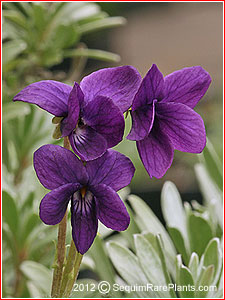
Viola odorata 'Clive Groves'
$12.95 Its small, sweetly fragrant flowers bloom very early in the year. The scent is strong and you do not have to wonder if your sniffer is working with this flower. The color is a deep, rich purple. A plant of this will send out short runners that become new plants. And within a season or two, one plant becomes a small colony.
.jpg)
Viola odorata 'Fair Oaks'
$12.95 Introduced by Canyon Creek Nursery in 1986, to quote their catalog, “originating in the garden of my family home, the color of this violet, unlike any other, is a delicate shade of lilac-pink. The medium sized flowers on long stems are extremely fragrant. The seeds come true and spread very rapidly making a nice woodland ground cover.” USDA zones 3 - 9.
.jpg)
Viola odorata 'Lydia Groves'
$12.95 The flowers of this are a light, candy pink that are sweetly scented. In 1989 it was selected in England by Clive Groves and named for his mother. The flowers have a single row of petals. The heart of the flower is a creamy white. It blooms very early in spring and again in fall. Its height is three to six inches.
.jpg)
Viola odorata (mauve)
$12.95 This flower is a grayish violet, very fragrant and low growing. It blooms early in the year, and often will rebloom as the days become cooler at the end of summer. Light shade is recommended. Adding some well rotted compost when planting is helpful. Young plants should be watered regularly to get them off to a good start. Once established, plants do not need more than average moisture. USDA zones 3 - 9. Sweet violets have been cultivated in gardens for a long time, not only for their beauty and fragrance, but also for their medicinal properties. They contain the glycoside of salicylic acid, which has been used for the synthesis of aspirin. It is no wonder herbalists have prescribed an infusion of this plant for treating headaches, migraines and insomnia.
.jpg)
Viola odorata 'Reid's Crimson Carpet'
$12.95 Introduced by Canyon Creek Nursery in 1998, to quote their catalog's description of 'Reid's Crimson Carpet,' “this makes a compact carpet of tidy, deep green foliage. In spring this mat is covered with brilliant crimson flowers which are nicely scented. Named for our son, Reid, who thinks we should have patented this violet to help towards his college fund. He might be right.”
.jpg)
Viola odorata var. rosea
$12.95 Fragrant, mid-pink blossoms show in early spring and again as the temperatures cool in autumn. Spreads by seeds and by runners.
.jpg)
Viola odorata ssp. sulfurea
$12.95 Our original plant of this came from Lamb Nurseries in Spokane, Washington. It has flowers of apricot with a single row of petals. For many years we thought this had no scent, although more recently we noticed a very light fragrance to a plant in flower in one of our greenhouses. According to Roy Coombs in his book,
Violets, the History & Cultivation of Scented Violets, this is probably a distinct species rather than a subspecies of
V. odorata. Dating from 1896 in France. USDA zones 3 - 9.
.jpg)
Viola odorata 'Duchesse de Parme'
$14.95 'Duchesse de Parme' originated in 1870 and is said to be the easiest Parma violet to grow. In America it has been one of the easier Parmas to find in recent years. Its fully double flowers are a violet blue, with creamy white closer to the center. It makes a charming tussie mussie or petite bouquet, with its six-inch stems. Its season is late winter into early spring, and again in early fall. Survives cold down to about +20°F.
.jpg)
Viola odorata 'Alba Plena'
$14.95 A Parma violet with strongly fragrant, double flowers of white, this plant sometimes has a small blush of a pale violet color at its center. Another name for it is 'Swanley White.' Its flowers have relatively long stems of five or six inches. Not as cold hardy as other violets, surviving to about +20°F. Rarely setting seeds, it produces new plants by sending out runners a short distance. These can be snipped from the mother plant once they begin to root in, and transplanted elsewhere in your garden.
.jpg)
Viola odorata 'Mrs. David Lloyd George'
$19.95 A semi-double lavender flower with a center rosette of white, that is fragrant and with long stems. Limited quantity. This rare violet is named for Dame Margaret Lloyd George (1864 - 1941), who was a Welsh humanitarian and one of the first seven women magistrates appointed in Britain in 1919, and also the wife of a British Prime Minister. Survives winter's cold to about +20°F.

.jpg)
.jpg)
.jpg)
.jpg)
.jpg)
.jpg)
.jpg)
.jpg)
.jpg)
